So far, we have encountered several kinds of interference:
- in-band signals: these signals can be very narrow - sometimes only a single weak
carrier is noticed - but also quite broad, but showing a rather fine structure. The
images below show what we labeled the "twin towers" at 1419.8 and 1420 MHz. The left
hand panel shows a single spectrum, where the fine structure within the signals is
visible, quite contrary to the noisy but smooth galactic emission feature at 1420.25 MHz.
In the waterfall map on the right hand panel we see that the signals get weaker and disappear
for some time, while the galactic features - we were scanning the Galactic Plane towards
the anticentre - get stronger. But as long as the interfering signals are well separated in
frequency from the galactic emissions, they do not pose a great problem. We simply
ignore them!
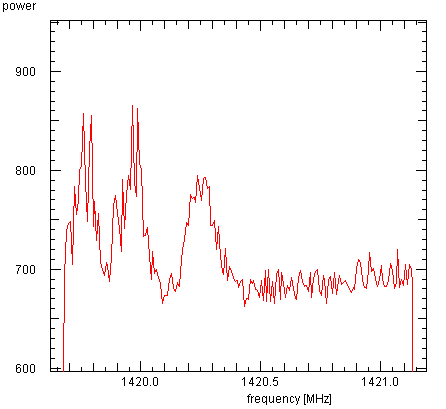
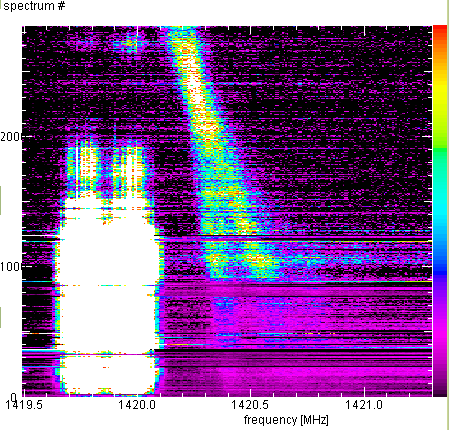
- other in-band signals: it occurred that a continuum signal below or above a certain frequency penetrates the frequency band under observation. One has the impression of a sharp cliff invading the spectrum. It did go away. At other times, one may see sharp single carriers at various frequencies. It seems that they are at the centre of each section of the frequency band, thus, with a 0.5MHz span one has only one spike in the spectrum.
- out-of-band signals: this winter, we could point to any direction in the sky and we received
a very low power level (about 50 cts), in stark contrast to other times - such as in the
first days of operation in summer 2009 - when the empty sky gave a reading of 800 cts.
We identified a nearby (about 400m distance) tower with cell-phone transmitters
causes the preamplifier to saturate, because in is original version has no selective filter
in front of the amplifying device (a MMIC). Thus, the preamplifier operates with low or
no gain, creating a weak receiver output. We did not find any clear pattern
for the occurrence of the very weak power levels, and so we simply tried to observe as often
as possible and at various times and days.
The plot below shows an experiment we ran overnight: During about 10 hours, we were observing the Galactic Anticentre l=180° b=0°. The left panel shows that during that time the received power level fluctuated rather strongly between about 50 and 700 cts, so between complete saturation and fairly decent reception. If one compares the apparent power of the galactic feature - properly baseline-subtracted, of course - with the power level of the nearby flat continuum (in the spectrum shown above one sess the flat region to the right of the galactic feature), one finds a very close correlation, depicted in the right hand panel below, each small circle representing one of the 3650 individual spectra: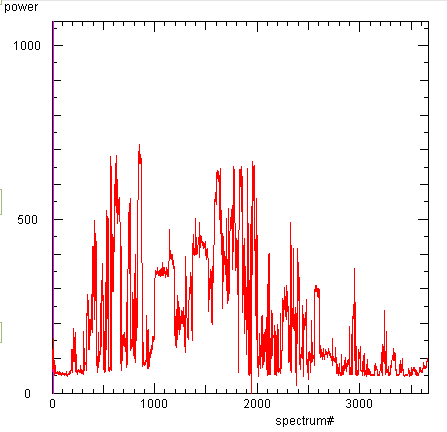
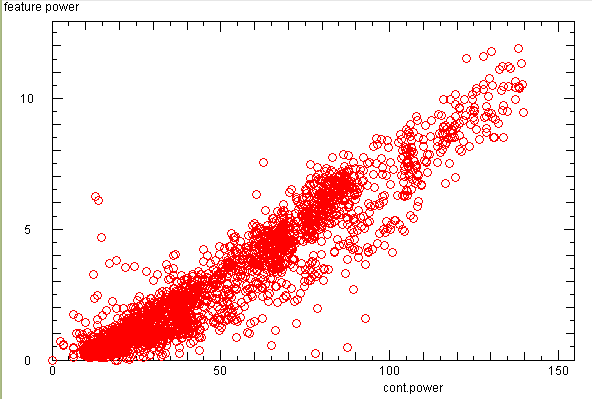
- if the power indicated was below about 200, there was very little chance to get any useable observations. If it was less than about 50, we gave up any hope! We had a coffee break, but we kept an eye on the software, until the situation sometimes got better
- if the power was more than about 200 - and if there were no strong in-band signals which would raise the power, of course - we could obtain decent results. If the power level also stayed reasonably constant, we could even interpret the data quantitatively!
Of course, we fought back, by building narrow-band filters to protect the receiver from the off-band interference, and after locating another problem in a leakage of the braid of a small coaxial cable, we no longer speak of interference ... Below shows the 2 resonator filter during initial tuning (before closed completely), and a screen shot of one of the swept measurements of the passband (about 150 MHz across the screen, the sharp dip near the centre marks 1400 MHz).
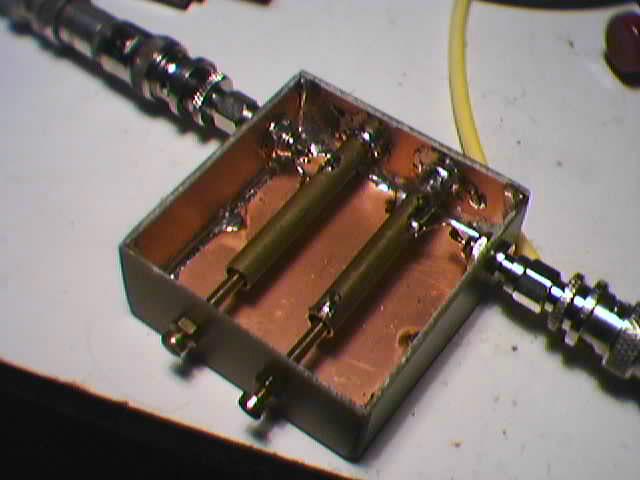

Here is my JavaScript tool to design interdigital filters
A variety of filters was built and tested. Initially, system temperatures of only 1000 K and 700 K could be reached, but this was already sufficient to execute complete surveys of the Milky Way, and getting reliable and interesting data. Although the filters were carefully tuned with 50 Ohm impedance equipment, their performance at the telescope left much to be desired. Obviously, the actual impedances of the preamplifier and the probe at the antenna's focus were not close to 50 Ohm. After various trials, a procedure was developed that permitted to tune reliably a filter to optimum response. This needs quite a bit of work, adjusting carefully the resonators, inspecting at each step the results at the computer, and finally measuring the system temperature. (One also benefits from good exercise, as one needs to walk many times the 120 m between telescope and computer :-)
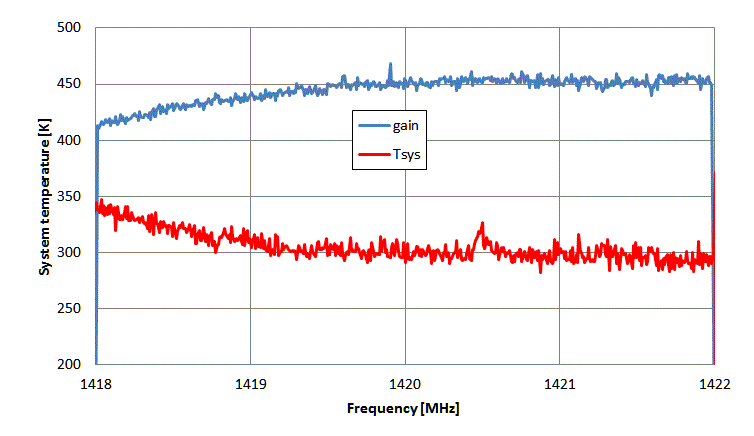
Eventually, a filter configuration was found that gives a sufficiently low system temperature over a broad frequency range, which also coincides well with the maximum overall frequency response, indicating successful power and noise matching. The narrow feature at 1420.5 MHz is merely due to the presence of galactic emission in the spectrum of the "empty sky".
| Top of the Page | Back to the MainPage | to my HomePage |
last update: June 2011 J.Köppen